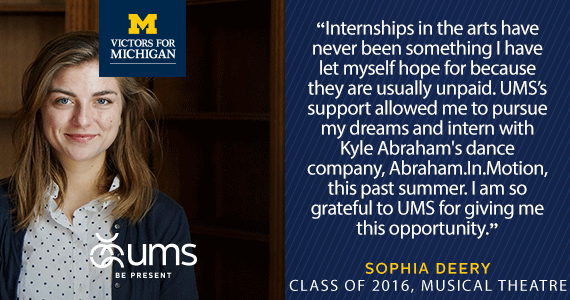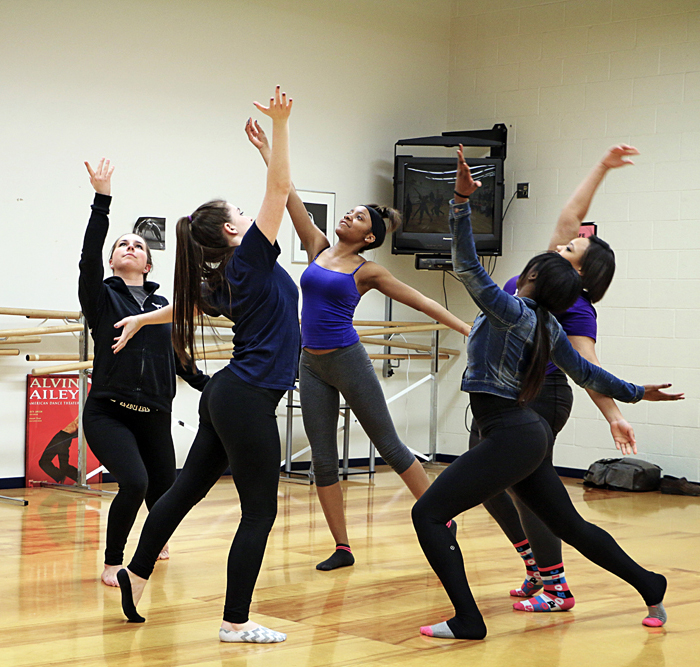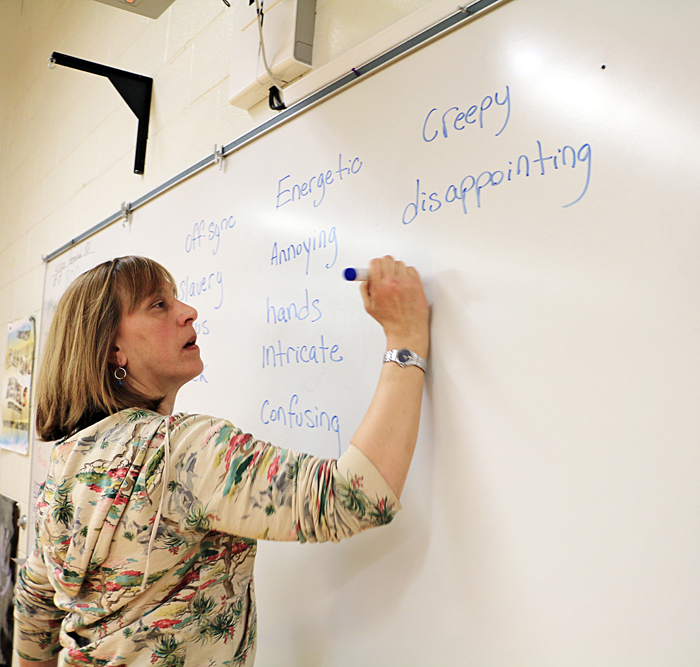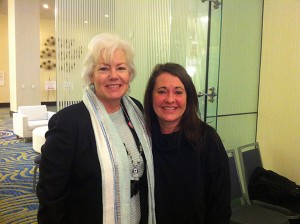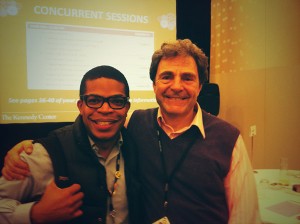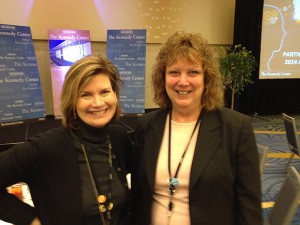At our Ovation Spring Gala
Our Ovation Spring Gala took place on May 14, 2016. Congratulations to honorees DTE Energy Foundation Educator of the Year Ann Arbor Public Schools Wines Elementary teacher Beth McNally and School of the Year Ann Arbor Public Schools Allen Elementary! Sincere thank you to all of our supporters. Ovation support helps UMS provide excellent educational experiences for K-12, university, and community.

With honorary chairs Jim and Sarah Harbaugh, chairs Sarah and Dan Nicoli, and University of Michigan president Mark Schlissel.

Honoree Beth McNally with UMS director of education & community engagement Jim Leija.

Honorees Allen Elementary with Coach Harbaugh.
Missed the gala? Ovation support helps UMS provide excellent educational experiences for K-12, university, and community. Make a gift today.
UMS Night School: Acting and Dancing Identity – Session 2 Recap
Please note: This post is a part of series about the free and open to the public UMS Night School. UMS Night School: Constructing Identity runs January 18-February 15, 2016.

Photo: Tanya Tagaq, who will be interviewed along with Taylor Mac at the next session of Night School on January 25. Photo courtesy of the artist.
This past Monday, I attended my first UMS Night School session. This was the second session in this year’s series, which focuses on identity and performance.
The session was about acting and dancing identity, with a focus on Young Jean Lee’s Untitled Feminist Show and Straight White Men, both of which were presented by UMS January 21-23, 2016. A discussion also prepared us for next week’s UMS Night School session with special guest artists Tanya Tagaq and Taylor Mac.
Jim Leija (UMS Director of Education and Community Engagement) and Clare Croft (U-M Assistant Professor of Dance) opened the session with an interactive movement activity. We participants picked a gesture that resonated with us from one of the shows we had seen over the weekend (if we had attended one). We were to perform the gestures without speaking, to emphasize the power of the motion we chose. We then got a chance to explain our gestures to each other.
What surprised you?
We discussed identity through acting and dancing, our expectations of the shows, and the role of society in influencing the creation and content of the shows. One of the main questions that was put on the table was: “What surprised you at the shows?” This question propelled a fantastic, insightful discussion about identity and cultural influence on identity.
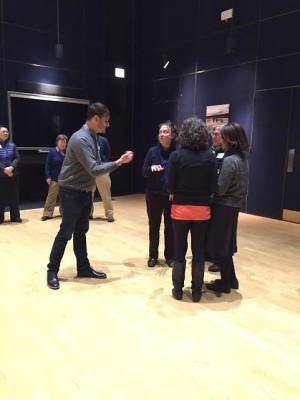 Photo: UMS Night School attendees perform their sound and motion as maestro Jim conducts them.
Photo: UMS Night School attendees perform their sound and motion as maestro Jim conducts them.
Jim and Clare closed the session with another interactive activity in which we created a “soundscape” for a picture that was projected onto a screen. The picture was of dogs pulling a sled through an arctic setting. Our class formed groups of four, and each group came up with a sound and action that we thought described some aspect of the picture. Maestro Jim then conducted the class in performing our sounds together. The result? Super awesome! It was nice to feel a sense of community with people I had never met before.
Having no preconceived expectation of the UMS Night School series, I found the class extremely engaging and by the end, I was so positively overwhelmed with so many new and exciting perspectives that I would’ve otherwise never been introduced to.
If you haven’t yet attended one of these classes, don’t wait any longer! Join us next week for a super exciting session to learn about constructing identity onstage with special guest artists Tanya Tagaq and Taylor Mac!
Artist Spotlight: Theater maker Rob Drummond
Editor’s note: Theater maker Rob Drummond’s Bullet Catch was part of UMS’s 2014-15 season. He returned this season for an extended educational residency, a collaborative effort between the University of Michigan’s Medical Arts program and UMS’s educational programs at U-M. As part of the residency, Rob is researching for a new play related to medicine. We asked him to write about his adventures in Ann Arbor.
November 6
I left the flat this morning at 4:30 am. I have not slept. And now the border control guy is doing his job. That’s all he’s doing. His job. Don’t blame him. Don’t get angry. That will only make things worse. I’m sitting in ‘the room.’ I’ve seen other people brought here but they were (borderline racism alert) not white, middle class, English speaking Brits like me. There’s an Asian woman sitting near me who looks on the brink of tears. As people in ‘the room’ often look. As I most likely look. I have tried to explain what I am doing over here.
Well, one thing I’m doing is running theater workshops for medical students.
The border control guy stares at me for around five seconds, like a dog trying to lip-read. And then replies …
Why?
Hmmm. How to explain my practice of cross-disciplinary, immersive artwork in one ‘get you across the border safely’ soundbite. Apparently, it can’t be done. So now I’m in ‘the room.’ And he’s on the phone to Mary Roeder, UMS Manager of Community Engagement, whose number I have got from the laptop that currently has 6% battery left. The laptop that has all the information about my stay here on it. And my adapter is in my suitcase. If that battery dies, then so do I. A bone-fide ticking clock drama on my hands here.
The longest three minutes of my life pass by before Mary calls back. She seemed to say the right things, and before I know it Officer Crocker was escorting me out of ‘the room’ and back into the airport. I hate Officer Crocker. Not because he was just doing his job. But because he did it with such grim authority. He is everything, I think, that the arts are not. He is the reason I make art. The world needs less of him.
November 7
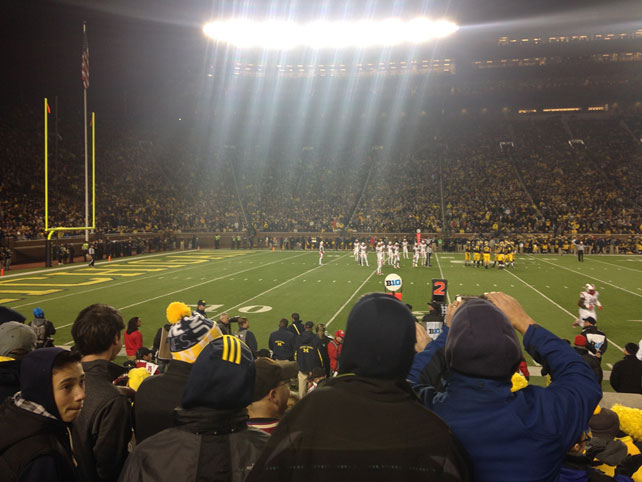
If America were a person, I’d recommend psychiatric help. This was my first thought upon walking into the stadium where one hundred and eight thousand people had gathered to watch college kids playing football. Pure theater. My second thought. I used to play rugby at a decent level for my college. I remember the time we had forty people show up to a game and spoke of it for years to come. Everything is bigger in America.
November 9
I got a look at the Kevorkian papers today. Incredible collection, and something I would not have been able to access without this residency. I didn’t realize Kevorkian was an artist as well as a doctor. As well as a murderer. But was he? Or did he just help desperate people to do something they couldn’t do themselves? His name is certainly whispered as that of some sort of a boogie-man figure, but reading through the letters of his patients, I couldn’t help but feel that he was doing some important work in a controversial way. He was certainly challenging the status quo. Challenging conventional notions of morality. And he certainly had confidence in his convictions. I couldn’t help but like him. But maybe I am romanticizing him. Much much more research is required before I can begin work on anything that is even remotely like Kevorkian, the Musical, as my fevered imagination had already titled the project I had, before today, never even considered working on.
In the afternoon I visit a patient presentation class, which plays out remarkably like a play. We are introduced to the main character, a real life patient, who reminds me slightly of Woody Allen, and then we are invited to re-visit his experience in being diagnosed with a mystery illness. I am trying my best to guess along with the students (incredibly intelligent, all) and, thanks to many many hours of watching medical dramas, I manage (in my head, I don’t dare raise my hand) to follow the case and even make some sensible assumptions. I am struck with an idea that I must speak to Joel Howell (U-M Professor ad doctor) about. Replacing an hour of lectures every term with a play which explores the medical and ethical dilemmas of a specific patient’s case. Sort of like this but more highly dramatized, using actors and performed in a theater (not that type). I need to stop having ideas for things I am not here specifically to work on.
In the evening my mind turns fully to the reason I am here. Interviewing medical students and doctors about their experiences. I am writing a play for the Royal Court Theatre in London, and I think Act Two will be a verbatim piece using the testimonies of said medics and, more specifically, the topic if delivering bad news. It fascinates me as a dramatist that these people spend so much time surrounded by death and yet seem so well-adjusted. Perhaps it is precisely because they spend so much time in and around the thing that the rest of us try to avoid that makes them so well-adjusted. Or perhaps they are not as well-adjusted as I think. As the interviews commence, I realize that it is a combination of the two. It also strikes me that perhaps medical students are the only group of people who think about death as much as artists do.
November 10
What I was finding hard to explain to Officer Crocker is that when I make a piece of theater, I often like to immerse myself in the world so that I can feel more authoritative when I write about it. I have trained as a magician (the show which originally brought me to Ann Arbor and started this whole crazy love affair), a wrestler, and a dancer for shows in the past, and now was the time to experience just a fraction of what medical students and doctors experience by accompanying Dr. Scally on trauma rounds.
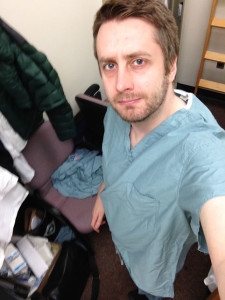
I get up at half-past ridiculous and make my way to the hospital. Which is like a small city. Feeling deeply intimidated and scared, I change into a set of scrubs. You can probably see in the photo below the mixture of fear and tired I was experiencing at this point. And then, as if I had always been a part of the team, as if it was the most natural thing in the world, I accompany two doctors, a resident, and a student (I think I’ve got that right) on rounds. Confidentiality precludes my mentioning anything specific but suffice to say it was an eye opening experience, my major take away being the feeling that doctors absolutely have to develop a dark sense of humor to get them through the day. They have to.
November 12
I have done a few workshops by this point and something that has struck me is that there really is little difference between the artists and the medical students. Whether it be improvisation, writing, or performing, they all enter into it with the same vigor. Both groups offer up insightful and interesting suggestions. Both are equally uncomfortable standing silently in front of the rest of the group. All the workshops are more or less effortless to deliver because the students are so…bright. One group came up with a brilliant play that was set at the top of the Empire State Building during its construction. Four workers on a metal beam, as in that famous photograph. In one-and-a-half hours together we fleshed out this idea, made it real. When I left, one of the students was sitting and writing in the hall. She said she had started writing the play we had just created. I was pleased. I went out and ate some food. Drank far too much beer (Apparently the Hop Cat loves a British accent). And when I came home again around half eleven…She was still there. Still writing.
It might have been the beer, but that made me choke up a little.
November 16
Really getting to know and like the people who are showing me such great hospitality while I am here. The interviews are going so well — getting so much incredible material. The students and doctors alike are amazingly open, to the extent that I am starting to feel guilty about milking them for their stories of misery. However, what has been coming out of this is the understanding that they are anything but miserable despite the fact they are surrounded by so much of it. They are doing a good thing with their lives. The delivery of bad information is not enjoyable, but the fact that they take part in such vital conversations, perhaps the most vital you will ever have, fills many of them with a kind of satisfaction. It’s a privilege. That’s a phrase I’m hearing a lot. It’s a privilege to be trusted with such a sensitive moment in a person’s life. To be sharing something real. Again, a massive similarity between artists and doctors presents itself. We are both looking for something real. We are both searching for truth. In many different ways.
November 17
I had a rip-roaring time at a trivia night last night (the only thing we won was an over-sized Miller Lite T-shirt which my wife is now wearing as a night-gown), but I was a good boy and didn’t drink too much as I knew I had to be up for another set of rounds, this time internal medicine, with Dr. Fine. As the picture below might suggest, this set of rounds did not require me to wear scrubs, so I felt a little less awkward. Again, I was welcomed into the fold as if I was just another medical student. The patients, I realized, didn’t have a clue that I wasn’t some world leading expert in something, which actually made me relax a little bit. Little did they know I was actually a nervous, anxiety ridden, socially awkward wreck. But actually, from the interviews I have conducted, I have come to realize that this is the normal way for a student to feel in a hospital.

These rounds are different. Less immediate danger. But more emotional somehow as the patients stories can be delved into in more detail. I come out feeling my respect for doctors deepen still. Dr. Fine genuinely cares about his patients. He cares not only about making them physically better but making sure they are emotionally cared for.
November 18
Another session with the Kevorkian papers is followed by my last workshop. We seem to save the best for last as together we come up with a concept for a play and create another world in an hour-and-a-half. This is the story of a young offender in prison. The twist is we never see her face. We only hear her voice and we learn about her through the visitors she receives. A really genuinely exciting concept created from nothing and fleshed out with characters, a plot line, and a question we collectively try to answer. What Price Truth? I’ve capitalized that question because it also works as the title. What is the truth worth? Should the girl lie for a reduced sentence or keep telling the truth and get life? Should we tell the difficult truths or lie for an easier life?
This cuts to the heart of the play I am working on for the Court. How do you tell someone they are going to die? Do you sugar coat or do you tell them the cold hard truth? Is it ever right to withhold information from a patient to spare their feelings? What Price Truth?
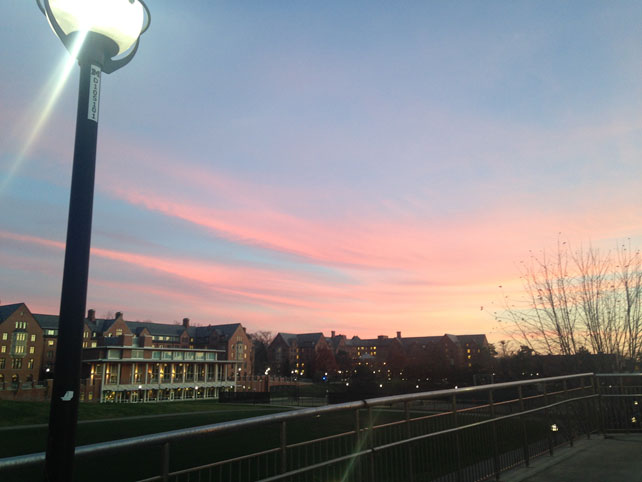
A good way to end my stay.
November 19
I left Michigan yesterday evening. And now I’m going through customs at Glasg-. Oh. I’m through. He barely looked at my passport. The joys of returning to your home country as a national. On my way though, I see a passenger has been taken aside (we don’t have the budget for a whole room apparently) and is being questioned. He doesn’t speak much English – he’s dark-skinned, possibly Indian, I’m not sure. The difference? This time the border control people are smiling. Joking with him. Trying to put him at ease. We’ll get this sorted. Don’t worry.
You see that Officer Crocker. That’s how you do it.
Rob Drummond is a writer, performer and director from Glasgow. His theater credits include Sixteen (Arches Theatre Festival), Hunter (National Theatre of Scotland and Frantic Assembly), Mr Write (Tron Theatre and the National Theatre of Scotland), and Rob Drummond: Wrestling (The Arches, winner of a Vital Spark Award), among others.
Free Dance Workshops for All
Lots of happy faces at our You Can Dance workshop and Breakfast Download Discussion event this weekend.

Photos by Sharman Spieser.
Interested in more? See the full listing of upcoming free activities open to all levels.
Student Spotlight: Artist Internships for the 21st Century
The fast changing environment of the 21st century poses new demands on artists. They must reach potential audiences in innovative and unexpected ways. To address these needs, the U-M School of Music, Theatre & Dance and University Musical Society (SMTD and UMS) launched a new student arts internship program for four SMTD undergraduate students in the summer of 2014. Chosen through a competitive application process, each student fellow interned for a minimum of five weeks between May and August 2014 with a professional dance, theater, or music ensemble that UMS planned presented during the 14-15 season. The program will continue and we’re currently selecting fellows for next season.
Explore the journeys of our 14-15 student fellows!
Héctor Flores Komatsu
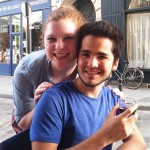 Héctor Flores Komatsu spent five weeks with Théâtre de la Ville in Paris, France. Read his travel stories while embedded with the company and his interview with company members.
Héctor Flores Komatsu spent five weeks with Théâtre de la Ville in Paris, France. Read his travel stories while embedded with the company and his interview with company members.
Libby Seidner
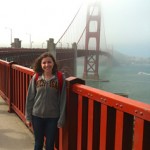 Libby Seidner was embedded with the San Francisco Symphony. Read her travel blog. Libby conducted video interviews with the orchestra, too:
Libby Seidner was embedded with the San Francisco Symphony. Read her travel blog. Libby conducted video interviews with the orchestra, too:
Sophia Deery
Sophia Deery was with Kyle Abraham’s Abraham.In.Motion company. Explore behind the scenes moments from the summer with the company, or photos from company’s residency in Ann Arbor. What she loves about the company’s work:
Hillary Kooistra
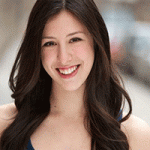 Hillary worked with the Trisha Brown Dance Company. Read her interviews with company members. We also worked with Hillary to create in-depth coverage of our free UMS Night School evening “course” focusing on dance.
Hillary worked with the Trisha Brown Dance Company. Read her interviews with company members. We also worked with Hillary to create in-depth coverage of our free UMS Night School evening “course” focusing on dance.
Interested in more? We can’t wait to introduce our next round of student fellows to you! Keep up with the program here on our blog.
Got questions or suggestions? Share them in the comments below.
UMS K-12 Workshops
Students at Farmington High School created their own dances in a post-show workshop led by UMS Education Coordinator Terri Park. Learn more about how UMS engages the community and check out upcoming events you can attend here.
UMS Education Coordinator Terri Park taking notes on how students felt about the Abraham.In.Motion School Day Performance.
At the Accessibility Immersion
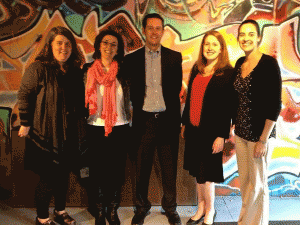
This October, UMS Education & Community Engagement hosted several events focused on accessibility, including a workshop for parents and caregivers and a day-long immersion for K-12 educators.
Pictured here, participants at the immersion. Photo by Kelly Van Singel.
Interested in learning more? Check our our other Education & Community Engagement programs.
Kennedy Center Annual Meeting Reflection and Report
The Kennedy Center’s Partners in Education Annual Meeting is a provocative, rewarding, and beyond worthwhile professional development experience…EVERY YEAR! I attend as part of the “Michigan 1997” partnership team, which also includes Robin Bailey (Ann Arbor Public Schools), Jennifer Scott-Burton (Washtenaw Intermediate School District), and Jim Leija (UMS). We get great work done as a team and spend individual time thinking slow, reflecting, and connecting with colleagues from around the country.
Some highlights:
Snow!
Equally as significant as the convening’s great content delivery was the precipitation delivery that shutdown DC, documented through many tweets.
In DC for a conference now. In my hotel people are trading pillows and remote controls for food. #dclockdown #jk
— Omari Rush (@RushOmari) February 13, 2014
#theycallthisasnowstorm? #kced http://t.co/zhLg0RHsUf — Jim Leija (@jimleija) February 13, 2014
Snow sculpture on the National Mall pic.twitter.com/f7oXfk4Ynb — Dave_Steele (@Dave_Steele) February 14, 2014
Sessions
MI 1997 was highly engaged in leadership roles at this year’s conference…maybe more so than any other team:
- The whole MI 1997 was a lead presenter in two sessions: “Making Partnerships Work” and “Preparing to Bring Students to Performances and Exhibits
- Jim gave a presentation on the new UMS TalkOut program at the “Bright Ideas” session (check out the slides)
- Robin is on the National Advisory Committee and had various facilitation duties
- Omari was on the Nominating Committee for the Advisory Committee
Other presenters led wonderful sessions too:
- Daniel Pink motivated us with his talk about embracing unconstrained work time…”Fedex Time”
- Ryan Hourigan spoke about the power of making the arts accessible and inclusive to students in special education programs (he’s a U-M PhD alum too!)
- Eric Jansen presented compelling and fully digestible brain research highlighting the connections between arts learning and personal development
- ALSO, Barbara Shepherd, Garry Golden, and Eric Booth extended their streaks of presenting bold ideas that invite paradigm shifts in thinking.
Outcomes
We get LOTS done too…and this this year we actually REDESIGNED our UMS K-12 Program!!! More soon…
Three Take Aways
- Commit to a Gaudy Goal: something that’s big, ridiculous, and creates stretch
- Make Learning Links Explicit: Sometimes the links are so obvious that we forget to do this.
- Integrate Advocacy: To be effective, impact assessment and sharing needs to be embedded rather than added on
Educational partners at work #kced @RushOmari #umslobby pic.twitter.com/KdCOo2Af3s
— Jim Leija (@jimleija) February 14, 2014
Inspiration
Our team finds bits of inspiration throughout the Annual Meeting, and some of that comes from hearing what’s inspiring others around the country.
Photos: From L to R: Barbara Shepherd with Jennifer Scott-Burton (left) and Omari Rush with Eric Booth (right).
What inspires you, Barbara?
“Connecting people to the people they need to know or connecting people to the resources they need to have. That’s what inspires me to come to work every day.”
— Barbara Shepherd, Kennedy Center’s National Partnerships Director, overseeing programs such as the Partners in Education Program and Any Given Child Initiative
What’s inspiring Eric Booth right now??
“El Sistema! Never before has he encountered an idea that has spread around the world with so many different manifestations, but that all have the same core idea of intense arts engagement that produces significant and meaningful social benefits, and each county working within El Sistema has unique social benefits that they are looking to realize. He’s really excited about this moment in time!”
— Eric Booth (who is described as “the father of the teaching artist profession” and “one of the 50 most important US arts leaders.”)
Photo: Robin Bailey (right) and Kathy Dewsbury-White (left)
What inspires you, Kathy?
“My great colleagues…the good ideas around the US…yeah, that’s what inspires me!”
— Kathy Dewsbury-White, Arts-Related and Integrated Professional Learning Coordinator for the Ingham Independent School District, and a member of the MI 2007 partnership team.
…and Jim captured video of his inspiration probe:
Now, back in Ann Arbor, our task is to use our refreshed minds to spur the positive change and development we envisioned at the Annual Meeting…it’s definitely possible…and already happening.
UMS Puppetry Immersion: Photos and Video
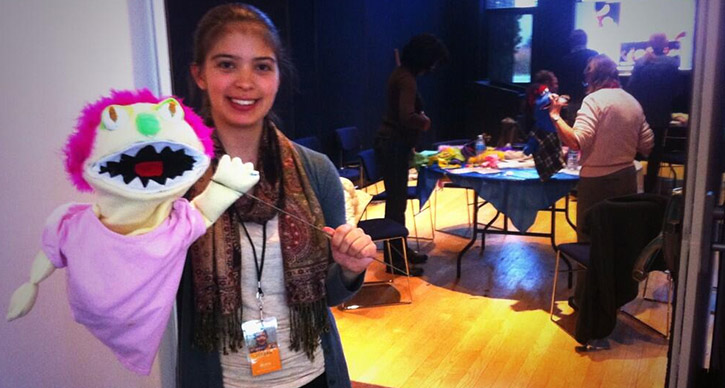
UMS Ed Intern Jordan with her freshly made muppet puppet at our Art of Puppetry Immersion. Photo by Omari Rush.
During a day-long puppetry immersion on November 2, 2013, participants create puppets of their very own through an exercise called “eye-bombing.” We pulled together some of your eye-bombing puppet photographs:
During another portion of the workshops, participants made their very own muppet puppets. Here’s what these puppets had to say in our in-venue video booth:
“This guy is going to be passed on to my four year old great nephew….”
“She doesn’t have a name or a voice yet but we’re working on it…”
“I just want to say that my hair looks so good today….”
Judy…
More puppet confessional video booth here.
Did you attend the immersion? What did you think? Share your thoughts and experiences in the comments below.
Education & Community Engagement at UMS
Outlier: Hauntings of the Avant-Garde
One night, long, long ago (about 10 days heretofore, to be exact), UMS and “experimental film happening,” HOTT LAVA, took over the former UMMA Off/Site space on the corner of S. University and Forest in Ann Arbor for an evening of performance, experimental film, music, and general merriment. Monikered OUTLIER: Hauntings of the Avant-Garde, this gathering was the culminating event of the much anticipated three-day celebration of the 50th anniversary of the ONCE Festival, and featured: Patient to Patient (Ryan Howard and Sean Patrick), Laurel Halo, Todd Osborn, Forest Juziuk, Chanel Von Habsburg-Lothringen, Jacob Mendel, Tom Buckholz, B. Thomas Hunter, Ted Kennedy, and others.
Herein, find a photo album of the evening’s activities. Thanks to Mark Gjukich for capturing these images.
(For those in attendance during the memorable/infamous/collective-scratching-of-heads moment better known in some circles as the “Gallon Challenge,” fear not…I have only included action shots of the milk in its native plastic jug. For those of you who are wondering what I’m talking about…ask me in person sometime. Or just Google it at your own peril. You should know in advance of your query that a true Gallon Challenge generally affords its contender a full 60 minutes to safely accomplish the feat. This was NOT the case at OUTLIER. Yikes.)
A Chat with Deb Clancy, UMS’s DTE Energy Foundation Educator of the Year
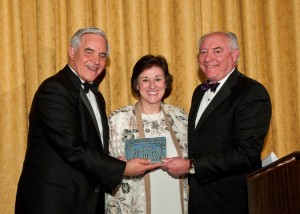 At the Ford Honors Program Gala Dinner on Saturday night, UMS presented its DTE Energy Foundation Educator of the Year Award to Deb Clancy from the Washtenaw Intermediate School District.
At the Ford Honors Program Gala Dinner on Saturday night, UMS presented its DTE Energy Foundation Educator of the Year Award to Deb Clancy from the Washtenaw Intermediate School District.
As the former Washtenaw Intermediate School District (WISD) Liaison to our UMS Youth Education Program, Deb Clancy has been a model steward, partner, and leader. Along with her “bend-over-backwards” brand of support, she provided insightful counsel when making programmatic and strategic decisions. Though Deb transitioned roles within WISD this season and is no longer the UMS liaison, her spirit of helpfulness and the support beams of her contributions remain embedded in our program and in our partnership with WISD.
Omari Rush, UMS’s Youth Education Manager, caught up with Deb recently to talk about arts education and how the schools are adapting to their new realities.
OR: You’ve worked with UMS for five years as the WISD liaison to the Youth Education Program. What did you particularly enjoy about this partnership?
DC: I really admire and commend UMS’s commitment to offering diverse programming across the spectrum of the arts: both to K-12 students and to educators in southeast Michigan. Its willingness to leverage boundary-spanning partnerships to realize creative projects for school communities is a model for what all educators will have to do in the coming years. As funding sources become less obvious, we’ll all need to work harder to find the opportunities in partnerships to secure additional support or funding for education-related endeavors.
OR: Tell us what pressing academic issues are facing the schools now.
DV: At the county level our focuses are on, of course, math and literacy, along with other areas such as early childhood education and personalized learning. While data from the MEAP testing show increases in student achievement in reading and math, we’re still working on closing achievement gaps between students of different socio-economic levels and between students of different ethnicities. The arts are certainly a factor in achieving these goals. Through our partnership with UMS we’ve been able to bring teaching artists to the area that provide our teachers with an array of creative strategies that help us improve student success and reach students as individual and unique learners. One example of an arts-infused workshop this year was “Math + Dance: Exploring Sequence and Combinations.”
OR: What do you see as the biggest opportunities in education?
DC: The national conversation in education is about 21st century skills; those essential skills that our children need to succeed as citizens and workers in the 21st century. Re-thinking content delivery so that learning goes beyond the traditional school walls and beyond the traditional school textbook is one area of opportunity for the general education community. The opportunity for the arts is to identify meaningful and proven methods for fitting into this framework. While we know that an arts-infused education is closely linked to student achievement, development, and engagement, there is ample opportunity to further refine and clarify these arts-related benefits and to create specific techniques for content delivery and integration.
OR: What would you like folks who don’t know UMS to understand about the program?
DC: UMS searches the world for renowned programs that focus on student involvement in the arts, programs that provide our students with academic and life skills; the programming really brings the arts to life for students of all ages. As a UMS teacher of the year shared three years ago, “UMS delivers the world, without you ever leaving the county.” I completely agree! Since 1990,UMS has touched and changed the lives of over two hundred thousand students through arts involvement. It’s really quite amazing!
Traveling to Africa…by way of Detroit
Each season, UMS emphasizes a geographic area of the world that is also represented by a significant population here in Southeastern Michigan. This year we focus on Africa, both in our main stage artistic presentations and in our community engagement work. We began six years ago with an Arab World music festival, followed by an Africa focus, a festival celebrating Mexico and the Americas, a focus on Asia, and we’re now repeating the cycle…in Africa once again. (more…)










































































































